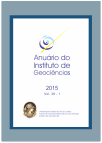Ostracods from Arade River Estuary, Algarve - Portugal
DOI:
https://doi.org/10.11137/2015_2_115_126Keywords:
Ostracoda, Biopolymers, Mesotidal estuary, Environmental compartimentationAbstract
The detrended correspondence analysis (DCA) applied to the relative abundance of ostracoda species and physical-chemical, sedimentological and geochemical parameters allowed to identified four sectors in the estuary of the Arade River: Sector I - located between the mouth of estuary and Portimão City and is characterized by the largest number of species of ostracoda, higher salinity and pH, sandy sediment and higher protein concentration. This sector has the largest marine influence with high phytoplankton productivity; Sector II - located in the vicinity of Parchal City, it is characterized by the highest value of diversity H' and the occurrence of the species Leptocythere lacertosa, Herpetocypris helenae and Leptocythere porcellanea. In this sector was identified the highest concentration of sulfur and fine sediments; Sector III - located between Silves and Parchal cities, has the highest concentration of organic carbon, fine sediment and biopolymers (carbohydrates, lipids and proteins). In this sector were identified only the dominant species in the estuary (Loxoconcha elliptica, Cytherois fischeri e Leptocythere lacertosa); Section IV - located in the Silves City, this sector had the highest lipid content and the silt fraction of the whole estuary. The sectors identified in Arade River Estuary, this is characterized as the most confined where the effluents from Silves City are deposited. The DCA analysis showed that the Loxoconcha ellipitica is the most characteristic species of this sector, and it can be considered with a confined environments bioindicator.Downloads
Download data is not yet available.
Downloads
Published
2016-05-10
How to Cite
Laut, L. (2016) “Ostracods from Arade River Estuary, Algarve - Portugal”, Anuário do Instituto de Geociências. Rio de Janeiro, BR, 38(2), pp. 115–126. doi: 10.11137/2015_2_115_126.
Issue
Section
não definida
License
This journal is licensed under a Creative Commons — Attribution 4.0 International — CC BY 4.0, which permits use, distribution and reproduction in any medium, provided the original work is properly cited.















